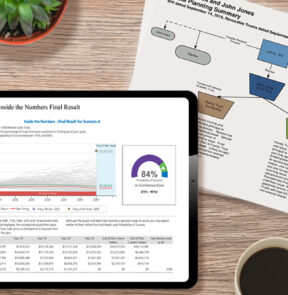SECURE 2.0 Act of 2022 was included in The Consolidations Appropriations Act, 2023 signed into law by President Biden on December 29, 2022. SECURE 2.0 further refines the SECURE Act of 2019 (SECURE 1.0) that provided sweeping changes to the treatment of inherited IRAs, among other things. The Treasury issued proposed regulations in February 2022 outlining the IRS’s interpretation of SECURE 1.0.
An underlying theme of SECURE 2.0 is to encourage retirement savings. The following focuses on some of its key provisions.
Retirement Plan Distributions:
Required Beginning Date (RBD) for Required Minimum Distributions (RMDs): RBD is April 1 of the year following the year a participant turns a given age.
- 70½ was the age prior to SECURE 1.0 (born before 7/1/1949)
- 72 became the age with SECURE 1.0 (born 7/1/1949 or later)
- 73 is the new age beginning in 2023 under SECURE 2.0 for those born in 1951 or later
- If you turned 72 in 2022, your RBD is 4/1/2023
- 75 will be the new age beginning in 2033. The law, as written, has internal inconsistences and is in need of a technical correction. It is not clear whether the age 75 will apply to those born in 1959 and after or simply after 1959.
RMDs for Roth 401(k)s: Beginning in 2024, Roth 401(k)s will no longer require RMDs. Note that RMDs related to the calendar 2023, even if they can be made in 2024, are still required to be paid. With this change, neither Roth IRAs nor Roth 401(k)s will have RMDs for the participant, or potentially for their surviving spouse.
Penalties for Failure to Take RMDs:
- Beginning in 2023, penalties will be reduced to 25% of the RMD amount not taken, down from 50%
- If the failure is corrected in a timely manner, then the 25% can be reduced to 10%
- Per SECURE 1.0 proposed regulations, penalties are waived for 2021 and 2022 in the case of inherited IRAs where the decedent died after 2019
Penalty-Free Early Withdrawals:
- This does not mean income tax free
- Generally there is a 10% penalty for withdrawals before age 59½
- Beginning in 2024, up to a $1,000 can be withdrawn for emergency expenses once during a year, and not more often than once every three years, unless the previous withdrawal has been paid back. This is added to the list of currently available penalty-free early withdrawals that include disability, substantially equal payments over life expectancy, deductible medical expenses, medical insurance for the unemployed, first-time homebuyers, education expenses, qualified birth or adoption, terminal illness, or an IRS levy. Some of these exceptions have limits on the amount of the withdrawal.
- Domestic Abuse: Beginning in 2024, a victim of domestic abuse can withdraw the lesser of $10,000 (indexed) or 50% of their retirement plan assets without the early withdrawal penalty. These amounts can be repaid to the retirement plan within three years, if desired.
- Qualified Federal Disasters: There will be no penalty for withdrawals of up to $22,000 for disasters occurring after January 26, 2021. The income from the withdrawal is also spread over three years and the withdrawal may be repaid.
- Long-term Care Insurance (LTCI): Beginning December 29, 2025, up to $2,500 per year may be withdrawn to pay LTCI premiums.
- Firefighters and certain other public service employees: Can begin penalty-free withdrawals at age 50, subject to certain length of service and other qualifications.
Qualified Charitable Distributions or QCDs: QCDs to qualified charities by IRA owners over age 70 ½ are still allowed, and the $100,000 per year limit will now index for inflation beginning in 2023. Each individual can have an annual QCD.
- Gift Annuities & CRTs: Now an individual can make a one-time gift of up to $50,000 from their IRA to a charitable gift annuity, charitable remainder unitrust (CRUT), or charitable remainder annuity trust (CRAT). Married couples could combine their gifts in funding one of these.
Retirement Plan Funding:
529 plans and Roth IRAs: Beginning in 2024, beneficiaries of 529 plans can make direct trustee-to-trustee rollovers to a Roth IRA for the beneficiary without tax or penalty. This person must have sufficient income and is still subject to annual contribution limits (currently $7,000), but are not subject to AGI limits. Up to $35,000 can be transferred from the 529 to a Roth over the beneficiary’s lifetime. The 529 must have been open for at least 15 years and cannot exceed the contributions and earnings in the 529 that existed more than five years before the rollover.
Catch-up Contributions: Employer-sponsored plans can allow participants age 50 or over to make $7,500 per year catch-up contributions in addition to the $22,500 maximum contribution amount allowed in 2023.
- Ages 60 to 63: Beginning in 2025, employees between ages 60 and 63 will be allowed catch-up contributions at a 50% higher rate than other employees over age 50 in employer-sponsored plans, with a $10,000 maximum. For non-SIMPLE plans the catch-up amount is $7,500 for 2023. This amount will index for inflation beginning in 2026. (Maximum will be $5,000 for SIMPLE plans with a current $3,500 catch-up amount.)
- Roth treatment if wages over $145,000: Beginning in 2025, for those over age 50 with wages in the prior year of $145,000 or more, any catch-up contributions in the employer plan are subject to Roth treatment (after-tax, not pre-tax). The $145,000 will be indexed.
- IRAs: IRAs also allow catch-up contributions of $1,000 for those over age 50. Beginning 2024, this amount will be indexed.
Roth Treatment of Employer Contributions: Plans can now allow employees to designate all or some of either (or both) an employer matching contribution or non-elective contribution as Roth contributions.
- SIMPLE and SEP plans can now be traditional or Roth.
Student Loan Payments: Beginning in 2024, employers are allowed to “match” qualified student loan repayments made by employees by depositing the “match” into their employer-sponsored retirement plan.
Automatic Enrollment: Beginning in 2025, most new employer-sponsored plans will be required to auto enroll new employees with a 3% to 10% savings rate with that rate automatically increasing at 1% per year up to a maximum of a 10% to 15% savings level. Employees can opt out of this.
Emergency Savings: Beginning in 2024, employers can match after-tax amounts that non-highly compensated employees contribute to an emergency pension-linked savings section in their retirement plan, with the employee’s contribution limited to $2,500. If the employee does not need the funds while employed, they can roll it into a Roth IRA or other Roth defined contribution plan.
Other Retirement Plan Provisions:
Qualifying Longevity Annuity Contracts (QLACs): QLACs are touted as a way to hedge against longevity risk as they typically begin payment when someone reaches their life expectancy. A person can now put up to $200,000 of their retirement assets into a QLAC and defer receipt of payments up until age 85. The $200,000 amount will be indexed for inflation going forward. Investing in a QLAC will reduce what would otherwise be the RMD, can have beneficiaries if someone predeceases, and is not appropriate for Roth accounts. As with any annuity, watch the details.
Prohibited Transactions: SECURE 2.0 clarified that if an individual engages in a prohibited transaction with their IRA, and if they have multiple IRAs, it is only the IRA that actually was used for the prohibited transaction that ceases to be an IRA and is deemed distributed to the individual.
Given the scope and nature of the changes in SECURE 2.0, it is important to consult your tax and other advisors to determine if there are any action steps that are appropriate for you.
At Fiduciary, we provide comprehensive wealth planning which integrates financial and estate planning, and considers the latest tax laws. If you would like to discuss your wealth planning needs, please reach out to one of our officers.



